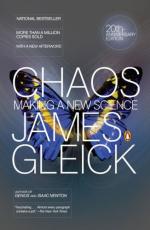|
This section contains 389 words (approx. 1 page at 400 words per page) |

|
Chaos: Making a New Science Summary & Study Guide Description
Chaos: Making a New Science Summary & Study Guide includes comprehensive information and analysis to help you understand the book. This study guide contains the following sections:
This detailed literature summary also contains Topics for Discussion and a Free Quiz on Chaos: Making a New Science by James Gleick.
"Chaos: Making a New Science" by James Gleick begins with the most basic knowledge of chaos as it is presented in weather. The book frequently returns to the information in Chapter 1, particularly the work of Edward Lorenz.
Gleick begins by discussing the weather simulator created by Edward Lorenz. The weather changed slowly yet it never rained, seasons never changed, and nightfall never arrived. Instead, the weather was always a permanent, dry condition as if it was the middle of the day in some midseason. Lorenz had created a type of weather Camelot. The year was 1960. Lorenz, a research meteorologist, was a fixture at the Massachusetts Institute of Technology. Although his machine broke down about once a week, Lorenz managed to mesmerize his colleagues. Gleick explains Lorenz's processes and numerical methods and applications that would make him the weather god in his own artificial universe.
In the 1960s, not only did meteorologists dislike forecasting, they also mistrusted computers. Computers seemed to these scientists like large calculators that were not competent enough to do the necessary computations. Edward Lorenz would change the way many people would think. Lorenz's experiments would prompt the development of the National Meteorological Center in the 1980s.
The book also introduces the works of many prominent scientists at length. This includes the work of John Yorke, the man credited with creating the term "chaos" in reference to science. Although Yorke was a brilliant mathematician, he often referred to himself as a philosopher. He was a dedicated admirer of Steve Smale, another famed scientist. Smale was a difficult but brilliant mathematician at the time that worked at and eventually directed the Institute for Physical Science and Technology.
Benoit Mandelbrot's work iss also discussed and recognized for its vital contribution to the science of chaos. Chaos is examined in many different lights and atmospheres from outer space to nature to the human body. Gleick also talks about modern day experiments.
Gleick is a gifted science writer in his own right. Gleick presents material in a straightforward manner. It is chronological in nature with historical referenced to Edward Lorenz and Benoit Mandelbrot as they are revisited and used by scientists that are involved in developing new theories. The book attempts to share these complex theories accessible for the lay person as well as the fledgling scientist.
Read more from the Study Guide
|
This section contains 389 words (approx. 1 page at 400 words per page) |

|



